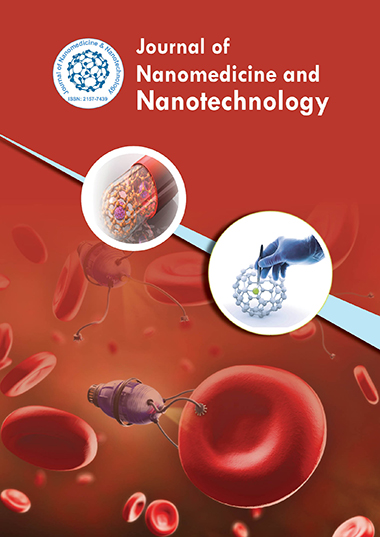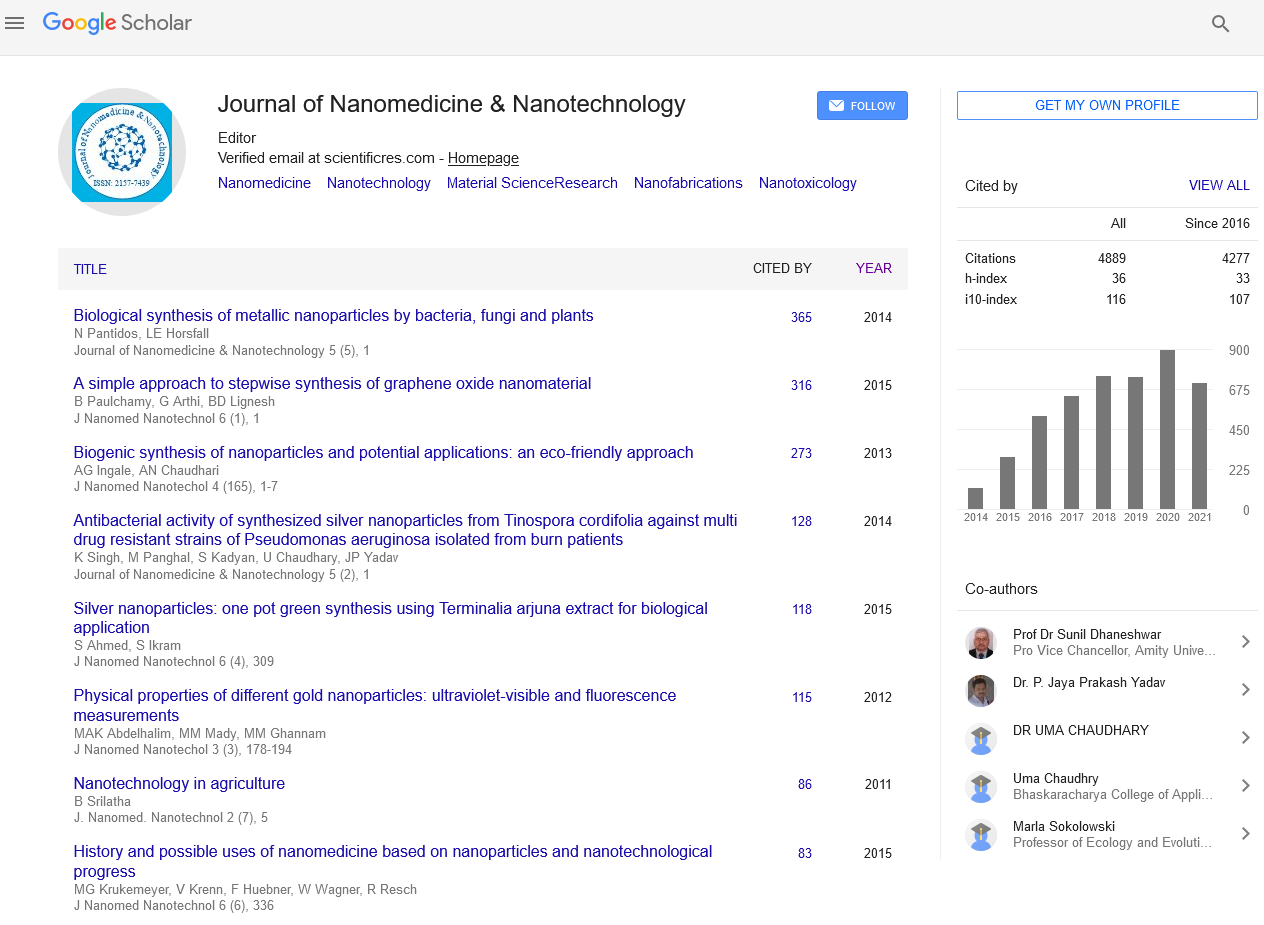Indexed In
- Open J Gate
- Genamics JournalSeek
- Academic Keys
- JournalTOCs
- ResearchBible
- China National Knowledge Infrastructure (CNKI)
- Scimago
- Ulrich's Periodicals Directory
- Electronic Journals Library
- RefSeek
- Hamdard University
- EBSCO A-Z
- OCLC- WorldCat
- SWB online catalog
- Virtual Library of Biology (vifabio)
- Publons
- MIAR
- Scientific Indexing Services (SIS)
- Euro Pub
- Google Scholar
Useful Links
Share This Page
Journal Flyer

Open Access Journals
- Agri and Aquaculture
- Biochemistry
- Bioinformatics & Systems Biology
- Business & Management
- Chemistry
- Clinical Sciences
- Engineering
- Food & Nutrition
- General Science
- Genetics & Molecular Biology
- Immunology & Microbiology
- Medical Sciences
- Neuroscience & Psychology
- Nursing & Health Care
- Pharmaceutical Sciences
Editorial - (2025) Volume 16, Issue 1
Nanoparticle-Based Virotherapy for Targeted Treatment of Human Papillomavirus (HPV) Related Cancers
Ptolemy Jefferson*Received: 01-Jan-2025, Manuscript No. jnmnt-25-28318; Editor assigned: 03-Jan-2025, Pre QC No. jnmnt-25-28318 (PQ); Reviewed: 16-Jan-2025, QC No. jnmnt-25-28318; Revised: 23-Jan-2025, Manuscript No. jnmnt-25-28318 (R); Published: 31-Jan-2025, DOI: 10.35248/2157-7439.24.16.771
INTRODUCTION
Human papillomavirus (HPV) is a group of more than 200 related viruses, some of which are known to be causative agents in the development of various cancers, including cervical, anal, and oropharyngeal cancers. HPV-related cancers are often associated with persistent infection by high-risk HPV types, such as HPV-16 and HPV-18, which integrate their viral DNA into the host genome, leading to the activation of oncogenes such as E6 and E7. These oncoproteins disrupt critical tumor suppressor pathways, particularly those involving p53 and retinoblastoma protein (Rb), resulting in uncontrolled cell proliferation and evasion of apoptosis. Although vaccination programs have made significant strides in preventing HPV infections, the treatment of HPV-associated cancers remains a significant clinical challenge, particularly in advanced or metastatic stages. Virotherapy, the therapeutic use of viruses or viral components to selectively target and kill cancer cells, has emerged as an innovative approach in cancer treatment. Among the various virotherapy strategies, the use of nanoparticles to deliver oncolytic viruses or viral-based therapies to cancer cells offers significant potential for enhancing therapeutic efficacy. Nanoparticle-based delivery systems offer advantages such as targeted delivery, reduced off-target effects, and controlled release, making them ideal candidates for treating HPV-related cancers. This article explores the potential of nanoparticle-based virotherapy in the targeted treatment of HPV-related cancers, focusing on the mechanisms, advantages, challenges, and future directions of this approach [1].
MECHANISMS OF NANOPARTICLE-BASED VIROTHERAPY FOR HPV-RELATED CANCERS
Nanoparticle-based virotherapy relies on the use of nanoparticles to encapsulate or deliver viral vectors, including oncolytic viruses or viral gene therapies, directly to tumor cells. Oncolytic viruses are naturally occurring or genetically modified viruses that selectively infect and kill cancer cells while sparing normal cells. These viruses can be engineered to preferentially target tumor cells by exploiting specific receptors or molecular features that are overexpressed on cancer cells. For HPV-related cancers, nanoparticles can be designed to deliver oncolytic viruses that target the HPV-infected tumor cells or inhibit the expression of viral oncogenes, leading to cell death [2]. The primary mechanism by which nanoparticles enhance virotherapy is by improving the delivery and release of the therapeutic viral agents at the tumor site. Nanoparticles can be engineered with specific surface modifications to target receptors on HPV-infected cells, such as integrins or other tumor-associated markers. Upon binding to the targeted receptors, nanoparticles are internalized into the cancer cells, where they release their viral payloads in a controlled manner, often in response to specific tumor microenvironment cues (e.g., low pH or the presence of specific enzymes). In the case of oncolytic viruses, nanoparticles can help protect the viruses from premature degradation by the immune system, allowing for more efficient viral replication and spread within the tumor. Once inside the cancer cells, the oncolytic virus can replicate and cause cell lysis, thereby directly killing the cancer cells. Additionally, the release of viral particles from infected cells can lead to the infection of neighboring tumor cells, creating a "bystander effect" that amplifies the therapeutic impact [3]. In some cases, nanoparticles may also be used to deliver viral-based gene therapies that specifically target and silence the expression of the viral oncogenes (E6 and E7) responsible for tumorigenesis. By inhibiting the expression of these oncogenes, nanoparticles can restore normal cellular functions, such as cell cycle control and apoptosis, thereby sensitizing cancer cells to other therapeutic interventions [4].
ADVANTAGES OF NANOPARTICLE-BASED VIROTHERAPY FOR HPV-RELATED CANCERS
Nanoparticle-based virotherapy offers several advantages over traditional cancer treatments, including chemotherapy, radiation, and immunotherapy. One of the most significant benefits is the ability to selectively target HPV-infected tumor cells. Because nanoparticles can be functionalized with targeting ligands, such as antibodies or peptides that bind to specific receptors on tumor cells, they can deliver viral agents directly to the cancerous tissue. This targeted delivery minimizes the risk of harming healthy cells and reduces systemic toxicity, which is a common issue with conventional therapies. Another advantage of using nanoparticles in virotherapy is the potential for controlled release of the viral payload. Nanoparticles can be engineered to release their contents in response to specific stimuli in the tumor microenvironment, such as acidic pH, enzymes, or the presence of certain ions. This ensures that the therapeutic agents are released at the site of the tumor, where they can exert their maximum effect, while minimizing exposure to non-target tissues [5]. Furthermore, nanoparticles can enhance the stability and bioavailability of oncolytic viruses or viral gene therapies. By encapsulating the viral payload in a nanoparticle, the therapeutic agents are protected from degradation by the immune system and enzymatic breakdown. This protection increases the likelihood that the viral agents will reach the tumor site in an active form, thereby enhancing their efficacy. Nanoparticle-based virotherapy also has the potential to overcome some of the limitations associated with viral therapies, such as viral clearance by the immune system. By shielding the viruses in nanoparticles, the immune response against the viral agents can be delayed, allowing the virus to replicate and spread within the tumor before being recognized and cleared. Additionally, nanoparticles can be used to co-deliver other therapeutic agents, such as chemotherapeutic drugs, immune checkpoint inhibitors, or immune-stimulating molecules, to enhance the overall treatment efficacy and stimulate an anti-tumor immune response [6].
CHALLENGES AND LIMITATIONS
While nanoparticle-based virotherapy holds great promise for the targeted treatment of HPV-related cancers, several challenges remain in the development and clinical application of this approach. One of the primary concerns is the potential for immune recognition and clearance of the nanoparticles and viral payloads. Although nanoparticles can provide some degree of protection against immune system recognition, they are still subject to phagocytosis by macrophages and other immune cells. The rapid clearance of nanoparticles from the bloodstream can limit their ability to deliver therapeutic agents effectively to the tumor site [7]. Another challenge is the potential for toxicity associated with the use of viral agents. While oncolytic viruses are designed to selectively infect and kill cancer cells, there is always a risk that they could also infect normal cells, particularly those that share similar receptor profiles with tumor cells. Additionally, the replication of oncolytic viruses within the tumor can trigger an immune response, which, while beneficial for tumor destruction, could lead to inflammation and toxicity in surrounding tissues. The heterogeneity of HPV-related tumors also presents a challenge in the development of effective nanoparticle-based virotherapy. HPV-related cancers can vary widely in terms of their molecular characteristics, tumor microenvironment, and response to treatment. Therefore, a one-size-fits-all approach may not be effective, and personalized treatment strategies may be required to optimize the therapeutic response [8].
FUTURE DIRECTIONS
Despite these challenges, the potential of nanoparticle-based virotherapy for the targeted treatment of HPV-related cancers is immense. Advances in nanotechnology, such as the development of biocompatible and biodegradable nanoparticles, can help address some of the issues related to immune clearance and toxicity. Furthermore, the incorporation of combination therapies, such as immune checkpoint inhibitors or targeted small molecules, with nanoparticle-based virotherapy can improve therapeutic outcomes by addressing multiple aspects of tumor biology [9]. Research into the optimization of nanoparticles for the delivery of oncolytic viruses and gene therapies will continue to evolve, with a focus on improving targeting, enhancing the stability of viral payloads, and reducing off-target effects. Clinical trials assessing the safety and efficacy of nanoparticle-based virotherapy in HPV-related cancers are crucial for advancing this approach from preclinical studies to clinical practice [10].
CONCLUSION
In conclusion, nanoparticle-based virotherapy offers a promising and innovative strategy for the targeted treatment of HPV-related cancers. By harnessing the advantages of both nanoparticles and oncolytic viruses, this approach has the potential to improve treatment outcomes, reduce systemic side effects, and provide a more effective alternative to traditional cancer therapies. With continued research and development, nanoparticle-based virotherapy could become a cornerstone of personalized cancer treatment in the future.
REFERENCES
- Iravani S, Korbekandi H, Mirmohammadi S V, Zolfaghari B. Synthesis of silver nanoparticles: chemical, physical and biological methods. Int J Pharm Sci.2014; 9(6): 385.
- Zhang N, Li X, Wang Y, Zhu B, Yang J. Fabrication of magnetically recoverable Fe3O4/CdS/g-C3N4 photocatalysts for effective degradation of ciprofloxacin under visible light. Ceramics International.2020.
- Liu S, Yu B, Wang S, Shen Y, Cong H. Preparation, surface functionalization and application of Fe3O4 magnetic nanoparticles. Adv. Colloid Interface Sci.2020; 102165.
- Mirza S, Ahmad M S, Shah A, Ateeq M. Magnetic nanoparticles: drug delivery and bioimaging applications. 2020; 189-213.
- Sorbiun M, Shayegan Mehr E, Ramazani A, Mashhadi A. Biosynthesis of metallic nanoparticles using plant extracts and evaluation of their antibacterial properties. Nanochemistry Research.2018; 3(1): 1-16.
- Cho J S, Hong Y J, Kang Y C. Design and Synthesis of Bubble-Nanorod-Structured Fe2O3â??Carbon Nanofibers as Advanced Anode Material for Li-Ion Batteries. ACS Nano.2015; 9: 4026.
- Asoufi H M, Al-Antary T M, Awwad A M. Magnetite (Fe3O4) Nanoparticles Synthesis and Anti Green Peach Aphid Activity (Myzuspersicae Sulzer). Journal of Computational Biology.2018; 6.
- Esmaili N, Mohammadi P, Abbaszadeh M, Sheibani H. Green synthesis of silver nanoparticles using Eucalyptus comadulensis leaves extract and its immobilization on magnetic nanocomposite (GOâ?Fe3O4/PAA/Ag) as a recoverable catalyst for degradation of organic dyes in water. Applied Organometallic Chemistry.2020; 34(4): e5547.
- Sandhya J, Kalaiselvam S. Biogenic synthesis of magnetic iron oxide nanoparticles using inedible borassus flabellifer seed coat: characterization, antimicrobial, antioxidant activity and in vitro cytotoxicity analysis. Materials Research Express.2020; 7(1): 015045.
- Singh J, Dutta T, Kim K H, Rawat M, Samddar P, Kumar P. Green synthesis of metals and their oxide nanoparticles: applications for environmental remediation. Journal of nanobiotechnology.2018; 16(1): 1-24.
Indexed at, Google Scholar, Crossref
Indexed at, Google Scholar, Crossref
Indexed at, Google Scholar, Crossref
Indexed at, Google Scholar, Crossref
Indexed at, Google Scholar, Crossref
Indexed at, Google Scholar, Crossref
Indexed at, Google Scholar, Crossref
Indexed at, Google Scholar, Crossref
Citation: Ptolemy J (2025) Nanoparticle-Based Virotherapy for Targeted Treatment of Human Papillomavirus (HPV) Related Cancers. J Nanomed Nanotech. 16: 771.
Copyright: ©2025 Ptolemy J. This is an open-access article distributed under the terms of the Creative Commons Attribution License, which permits unrestricted use, distribution, and reproduction in any medium, provided the original author and source are credited.


